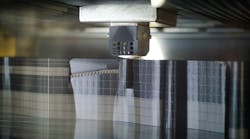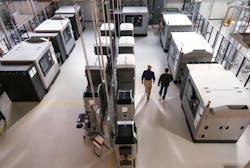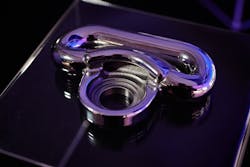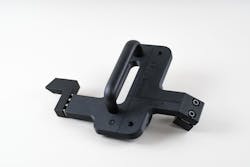General Motors Builds Happier Employees With Additive Manufacturing
When “after-school” technology explorers meet corporate investigation of said technology, that’s when a manufacturer knows it’s really on to something.
In the mid-2010s an after-school club of GM employees enthusiastic about additive manufacturing investigated the technology amongst themselves, trying to understand the impetus and business case for investing further in additive. Unbeknownst to the group, senior executives at GM were already observing how the aerospace and medical industries were leveraging additive for more than prototyping.
Thanks to the cooperation that blossomed, in 2022, GM’s use of additive has matured well beyond prototypes and low-volume parts. The nation’s largest automaker prints custom tools for plant operators, making their jobs safer and more productive. It’s gone as far as embedding additive machines into plants where 3D printing enthusiasts make themselves known.
Loading in the Building Blocks
In 1989, General Motors installed an early 3D printer, a stereolithography machine with the serial number “3”—literally the third machine to roll off the line—in the Warren (Michigan) Tech Center campus near Detroit. So began the company’s relationship with additive manufacturing.
“And it was really because our senior executives bought into the idea and the promise of additive as a future and were willing to take a bet and study this and understand where it could lead.”
“Primarily, for almost three decades, what we did with additive was prototyping during design concepts and engineering development, early-stage stuff that we wouldn’t typically publish externally but was a huge enabler for the work that we do internally in product development, in the design studios and everything in between,” says Ali Shabbir, engineering group manager at GM for industrializing additive manufacturing and a member of that after-school club.
“As the technology, the material strengths, the availability of metals began to really start to hit its stride, the executives said ‘You know what, this is something that we really need to pay attention to, so let’s put a small team on this to really explore what could be done,’” says Brennon White, an additive design and manufacturing technical specialist who holds several additive manufacturing patents and another club member.
“I’ve talked to multiple other companies about this, where they ask, ‘How did you get the C-suite level executives to buy into additive without having a killer application or a killer business case for a known project?’” says Shabbir. “And it was really because our senior executives bought into the idea and the promise of additive as a future and were willing to take a bet and study this and understand where it could lead.”
Driving the Demand for Additive
In 2019, GM encouraged its budding additive enthusiasts with the opening of the Additive Innovation Lab (AIL), a 4,000 sq. ft. facility in Cole Engineering Center in the Global Technical Center. Shabbir describes the AIL as the crown jewel of GM’s additive education program, a DIY maker space and learning center where employees learn how to design and set up additive builds and post-process parts.
Arguably a measure of these enthusiasts’ influence on the company at large, in 2020, the Additive Industrialization Center (AIC) opened, also located in Warren, a standalone 15,000 sq. ft. greenfield facility with 3D printers that work in polymer and metal, dedicated to promoting large-scale additive technology deployments.
Shabbir says the AIC lists more than 5,000 unique part numbers. White adds that, if one counts all the components of a unique part individually, that the AIC produces tens of thousands of parts annually.
GM’s work with additive in auto manufacturing naturally takes the spotlight. High-profile examples include:
- 3D printing 75% of the parts in 2020 for the nonoperational prototype (not the production vehicle) of the first 2020 Chevy C8 Corvette, allowing engineers to study the final assembly process and identify production challenges
- Producing 2020 racing season additive parts for the Corvette C8.R, INDYCAR, NASCAR Camaro, and Silverado race teams
- Additively manufacturing in 2021, via partnership with GKN Additive Forecast 3D, 60,000 flexible “spoiler closeout seals” to complete 30,000 Chevrolet Tahoe SUVs in five weeks—injection molding would have taken 10 weeks longer
- Incorporating 3D printed parts, including two HVAC ducts and an electrical harness holder into Cadillac CT4-V and CT5-V Blackwing vehicles
- GM in October announced the $300,000 Cadillac CELESTIQ EV, that will make extensive use of metal additive manufacturing for made-to-order customizations
GM limits direct additive part manufacturing to these sorts of low-volume jobs owing to additive’s high cost and slow speed compared to traditional manufacturing. While Shabbir is an additive devotee and would like to think big, he understands the primacy of business considerations.
“I'd love to get a 3D-printed part onto the (Chevrolet) Silverado and the (GMC) Sierra (pickups), our highest volume vehicles, but from a ‘Can I print it?’ and ‘Should I print it?’ perspective, which are the two questions that we’ll ask ourselves, the ‘Should I print it”’ is almost always a no,” Shabbir says. “It doesn’t make business case sense or economic sense to 3D print a part at very high volumes.”
“It doesn’t make business case sense or economic sense to 3D print a part at very high volumes.”
Printing Tools for Making Cars
Today, the manufacturing engineering team tours plants to hold discovery workshops and look for opportunities to assist operations with additively manufactured tooling. According to Shabbir, almost all North American plants use 3D printing in some capacity. Discovering a local enthusiast makes all the difference.
“Additive manufacturing is not just goingto be dropped [in a plant] without an enthusiast, without an owner in the plant that’s going to really take ownership to deliver results with that,” Shabbir says.
There are plenty of examples Shabbir and his team may give to explain to plant operators why additive holds value for them. Arguably more important for day-to-day operations but less publicized, GM invests significant time and resources into additively manufacturing tooling, saving the company money and improving the working lives of its operators.
GM’s Lansing Delta Township plant has for several years benefitted from an additively manufactured tool, used as a bridge to a more permanent, long-term tool, to align engine and transmission vehicle identification numbers. The part costs $3 for GM to produce additively. If outsourced, the part might cost $3,000 to manufacture through traditional methods. The Lansing Delta Township plant saves hundreds of thousands of dollars on that individual tool.
At the Arlington Assembly plant in Texas, operators use 3D-printed hand tools made of a nylon carbon fiber composite that weigh 3 pounds and replaced aluminum tools that weigh between 10 pounds and 40 pounds. It took less than four weeks to produce the additively manufactured tools, versus two months for the aluminum versions.
“I would say more often than not it’s just a continuous improvement, Kaizen-type exercise that’s built into how we’re doing things,” Shabbir says. “But the mechanism by which that happens is an operator will suggest their ideas to their supervisors and then those ideas get funneled in through the plant’s additive contact. That person is tied into our central office, the AIC.”
Sometimes this means that Kyle Sinko, who leads manufacturing engineering at the AIC, and his team collaborate on a CAD file for a design. If the plant in question has additive capability, it receives the CAD file to print the part locally. If the plant does not, the AIC prints the part and sends it to the plant.
“But the goal is to put something like unit cells of printers in many of our strategic manufacturing plants and then be able to have that [design] exercise be done inside the plant and then share it out with the rest of the network,” Shabbir says.
“One of the most successful events I remember in our early startup phase was we actually went to a plant and had a workshop there to say ‘Hey, how could additive really help the plant out?’” White says. “We had dozens of projects that came out of that particular exercise. We were able to get some components supplied to the plant within days,” for instance a mutilation guard to assist operators screwing headliners in place.
“Imagine you miss with the screwdriver and puncture the headliner. You have to replace that headliner. We came up with a guard to allow the operators to not even worry about getting in there [with the screwdriver],” White says. “Not only did we help protect that headliner, but we also got the operation done right first time, every time.”
Standardization becomes a chief benefit of spreading additive processes to as many plants as possible.
“If one issue is popping up at a plant and it’s been solved using additive, it’s very likely that many of the other plants are facing the same issue and there should be sharing of knowledge,” Shabbir says. “We’ve created a 3D printing parts catalog internally to allow the plants to go and see what other solutions have been done. Perhaps there’s a solution to their problem already.”
“You need the passion and the enthusiast. You need an individual that’s willing to go divergent and find those solutions and dedicate the time to doing that.”
Additive Enthusiasts Print the Future
Shabbir's department spends considerable time trying to find the sort of persons who would have joined the after-school additive club if they'd worked in Warren back in the mid-2010s.
“One of the challenges that you often see in additive is people are still a little bit distrusting of the technology,” White says. “It’s materials, it’s a process, and getting somebody that’s really interested in the technology allows them to absorb all of the things that are required to get the nuances.”
“You need the passion and the enthusiast. You need an individual that’s willing to go divergent and find those solutions and dedicate the time to doing that,” Shabbir says. “You need an executive champion. You need someone that actually cares enough to go fight the battles for you. It might not be millions of dollars every time, it could just be giving you the time of day to go and actually explore and take your learnings and network them across the organization and showcase them.
“Then you need someone in between those two, that’s kind of a do-er, because oftentimes you have the enthusiast who’s more of a dreamer but may not actually be able to get additive implemented into standard processes and practices,” Shabbir adds.
The ultimate mission for Shabbir and White is to plant additive manufacturing techniques into GM's corporate DNA so firmly that the technology, rather than a new and exciting technique becomes a normal, everyday aspect of doing business.
“The next step for us is to standardize additive formally as part of product development. It’s still kind of weaving its way in, but ensuring additive is captured in our documentation and our execution strategies and even just the milestones of our product development timeline to incorporate additive…we’re actively working on that, and at that point it becomes self-sustaining,” Shabbir says.
“Our leadership from the mid-level management down, even top-level management to be honest with you, believes in us to a point where they say ‘If you’ve got a small component that’s very low volume…did you check with the additive group? If not, when are you going to check and get back to me?’ because that spawns a tremendous number of applications,” White says. “And that’s why we usually do about 50 applications a week, because the entire management team understands that additive is part of our culture.”













